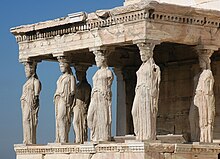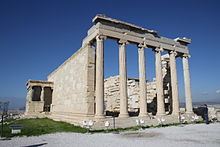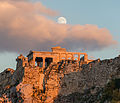Erechtheion
| Erechtheum | |
|---|---|
Ἐρέχθειον (in Greek) | |
 | |
 | |
| General information | |
| Type |
|
| Architectural style | Ionic |
| Location | Athens, Greece |
| Current tenants | Museum |
| Construction started | 421 BC[1] |
| Completed | 406 BC[1] |
| Owner | Greek government |
| Design and construction | |
| Architect | May have been Mnesikles |
The Erechtheion or Erechtheum (/ɪˈrɛkθiəm, ˌɛrɪkˈθiːəm/; Ancient Greek: Ἐρέχθειον, Greek: Ερέχθειο) is an ancient Greek temple on the north side of the Acropolis of Athens in Greece which was dedicated to both Athena and Poseidon.
Architecture[]

The temple as seen today was built between 421 and 406 BC. Its architect may have been Mnesicles, and it derived its name from a shrine dedicated to the legendary Greek hero Erichthonius. The sculptor and mason of the structure was Phidias, who was employed by Pericles to build both the Erechtheum and the Parthenon. Some have suggested that it may have been built in honor of the legendary king Erechtheus, who is said to have been buried nearby. Erechtheus was mentioned in Homer's Iliad as a great king and ruler of Athens during the Archaic Period, and Erechtheus and the hero Erichthonius were often syncretized. It is believed to have been a replacement for the Peisistratid temple of Athena Polias destroyed by the Persians in 480 BC.[2]
The need to preserve multiple adjacent sacred precincts likely explains the complex design. The main structure consists of up to four compartments, the largest being the east cella, with an Ionic portico on its east end. Other current thinking[3] would have the entire interior at the lower level and the East porch used for access to the great altar of Athena Polias via a balcony and stair and also as a public viewing platform.
The entire temple is on a slope, so the west and north sides are about 3 m (9 ft) lower than the south and east sides. It was built entirely of marble from Mount Pentelikon, with friezes of black limestone from Eleusis which bore sculptures executed in relief in white marble.[4] It had elaborately carved doorways and windows, and its columns were ornately decorated (far more so than is visible today); they were painted, gilded and highlighted with gilt bronze and multi-colored inset glass beads. The building is known for early examples of egg-and-dart, and guilloche ornamental moldings.[5] In the Theory of Mouldings (1926), Charles Howard Walker has detailed drawings of some of the decorations.[6]

Porch of the Maidens[]
On the north side, there is another large porch with six Ionic columns, and on the south, the famous "Porch of the Maidens", with six draped female figures (caryatids) as supporting columns. The porch was built to conceal the giant 15-ft beam needed to support the southwest corner over the Kekropion, after the building was drastically reduced in size and budget following the onset of the Peloponnesian war.
Mythological past[]
The Erectheum was associated with some of the most ancient and holy relics of the Athenians, such as the Palladion, a xoanon or "wood-carven effigy" of Athena Polias (Protectress of the City),[7] and some of the holiest sites: the marks of Poseidon's trident and the salt water well (the "salt sea") called the Erechtheis that resulted from Poseidon's strike; and the sacred olive tree planted by Athena in her successful rivalry with Poseidon for the city;[7][8] the supposed burial places of the mythical kings Kekrops and Erechtheus;[7] the sacred precinct to Kekrops' daughter Pandrosus;[a][7][9] an altar to the tribal hero Boutes.[10][7] The shrine (heroön) to Pandion[b] is included as part of the Erectheum by some scholars.[11]
The mark in the rock left by Poseidon's trident left seen to posterity;[12] the saltwater well was seen within the Erectheum.[13]

The olive Athena is supposed to have planted grew in the Pandroseion, in an enclosure west of the Erectheum.[14] An olive tree remains on the Western side of the Erechtheus, though it was planted there in modern times by Sophia of Prussia, granddaughter of Queen Victoria, in honour of the Athenians. In front of the main statue, a golden lamp called "asbestos lychnia" made by the sculptor Callimachus burned continuously with its asbestos wick and was refuelled once a year.[15]
The eastern part of the building was dedicated to Athena Polias, while the western part served the cult of Poseidon-Erechtheus and held the altars of Hephaistus and Boutes, brother of Erechtheus.[16][17] According to the myth, Athena's sacred snake lived there.[17] The snake was fed honey-cakes by Canephorae, the priestesses of Athena Polias, by custom the women of the ancient family of Eteoboutadai, the supposed descendants of the hero Boutes. The snake's occasional refusal to eat the cakes was thought a disastrous omen.[18]
Late antiquity and the Middle Ages[]
The Erechtheion underwent extensive repairs and reformation for the first time during the 1st century B.C., after its catastrophic burning by the Roman general Sulla.[19] The intact Erechtheum was extensively described by the Roman geographer Pausanias (1.26.5 - 27.3), writing a century after it had been restored in the 1st century AD.[20]
Pausanias described it in the 2nd century:
- There is also a building [in Athens] called the Erekhtheion . . . Inside the entrance are altars, one to Poseidon, on which in obedience to an oracle they sacrifice also to Erekhtheus, the second to the hero Boutes, and the third to Hephaistos . . . here is also inside--the building is double--sea-water in a cistern. This is no great marvel, for other inland regions have similar wells, in particular Aphrodisias in Karia. But this cistern is remarkable for the noise of waves it sends forth when a south wind blows. On the rock is the outline of a trident. Legend says that these appeared as evidence in support of Poseidon's claim to the land.[21]
If still in use by the 4th-century, the temple would have been closed during the persecution of pagans. The building was altered decisively during the early Byzantine period, when it was transformed into a church dedicated to the Theometor. With this alteration many architectural features of the ancient construction were lost, so that our knowledge of the interior arrangement of the building is limited.[19][22] It became a palace under Frankish rule and the residence of the Turkish commander's harem in the Ottoman period.[17][23]
Modern times[]

In 1800 one of the caryatids and the north column of the east porch together with the overlying section of the entablature were removed by Lord Elgin in order to decorate his Scottish mansion, and were later sold to the British Museum (along with the pedimental and frieze sculpture taken from the Parthenon).[1][24][25] Athenian legend had it that at night the remaining five Caryatids could be heard wailing for their lost sister. Elgin attempted to remove a second Caryatid; when technical difficulties arose, he tried to have it sawn to pieces. The statue was smashed, and its fragments were left behind. It was later reconstructed haphazardly with cement and iron rods. A piece of a carved female figure sculpture identified as belonging to the Erechtheion frieze was acquired by English Architect Sir John Soane and is currently on display at Sir John Soane's museum in Holborn, London.[26]
During the Greek War of Independence the building was bombarded by the Ottomans and severely damaged,[17] the ceiling of the north porch was blown up and a large section of the lateral walls of the cella was dismantled.[27] The Erechtheum went through a period of restoration from 1977 to 1988.[28]
Previous attempted restorations by Greece damaged the roof of the Caryatids' porch with concrete patches, along with major damage caused by pollution in Athens. In 1979, the five original Caryatids were moved to the Old Acropolis Museum and replaced in situ by exact replicas. Scientists were working in 2005 to repair the damage using laser cleaning.[citation needed]
The restoration of Erechtheion received the Europa Nostra award.[29]
Recent events[]

One of those original six figures, removed by Lord Elgin in the early 19th century, is now in the British Museum in London. The Acropolis Museum holds the other five figures, which are replaced onsite by replicas. The five originals that are in Athens are now being exhibited in the new Acropolis Museum, on a special balcony that allows visitors to view them from all sides. The pedestal for the Caryatid removed to London remains empty. As of 2011, they are being cleaned by a specially constructed laser beam, which removes accumulated soot and grime without harming the marble's patina.[30]
Each Caryatid is cleaned in place, with a television circuit relaying the spectacle live to museum visitors. Although of the same height and build, and similarly attired and coiffed, the six Caryatids are not the same: their faces, stance, draping, and hair are carved separately; the three on the left stand on their right knee, while the three on the right stand on their left knee. Their bulky, intricately arranged hairstyles serve the crucial purpose of providing static support to their necks, which would otherwise be the thinnest and structurally weakest part.
The Caryatids have been transferred from the Old Acropolis Museum to the New Acropolis Museum.[31] The first was carried over safely on December 9, 2007, via an elaborate system of aerial cranes.[32][33] Within the new museum, the statue was reunited with its long-missing sandalled left foot, which was identified among rubble in the 1980s. The reassembled Caryatid, along with the four others remaining in Athens, are having their decayed patina thoroughly restored by laser, and are on display in the new museum.[34] Visitors today can see this process being carried out via camera in the gallery where the Caryatids are displayed in the museum. The Acropolis Museum was awarded for its innovative program of the conservation and the restoration of the Caryatids by the International Institute for Conservation (IIC) in Vienna, with the Keck Award 2012.[35][36]
Gallery[]

Athens Erechtheum Southern flank, 2009

Erechtheion, 2014

Erechtheum Acropolis Athens with evening moon, 2015

Erechtheion, 2017

Erechtheion in 2017

Painting of the Erechtheion, by Werner Carl-Friedrich, from 1877
See also[]
| Wikimedia Commons has media related to Erechtheum. |
- List of Greco-Roman roofs
- St Pancras New Church, London (design inspired by the Erechtheum)
Explanatory notes[]
References[]
- Citations
- ^ Jump up to: a b c Langmead, Donald; Garnaut, Christine (1 December 2001). Encyclopedia of Architectural and Engineering Feats. ABC-CLIO. pp. 110–112. ISBN 978-1-57607-112-0. Retrieved 24 July 2012.
- ^ Garland, Robert (1992). Introducing New Gods: The Politics of Athenian Religion. Cornell University Press. pp. 175–. ISBN 978-0-8014-2766-4. Retrieved 24 July 2012.
- ^ Lesk, Alexandra L. (2004). A Diachronic Examination of the Erechtheion and Its Reception (PhD). University of Cincinnati. ucin1108170608.
- ^ Watkin, David (July 2005). A History of Western Architecture. Laurence King Publishing. pp. 39–. ISBN 978-1-85669-459-9. Retrieved 24 July 2012.
- ^ Lewis, Philippa & Gillian Darley (1986) Dictionary of Ornament, NY: Pantheon
- ^ Walker, Charles Howard (1926). The Theory of Mouldings. J. H. Jansen. hdl:2027/mdp.39015011971556.
- ^ Jump up to: a b c d e Orlin, Eric, ed. (19 November 2015), "Erechtheion", Routledge Encyclopedia of Ancient Mediterranean Religions, p. 310, ISBN 978-1-134-62552-9
- ^ Hurwit, Jeffrey M. (1999). The Athenian Acropolis: History, Mythology, and Archaeology from the Neolithic Era to the Present. Cambridge University Press. p. 32. ISBN 978-0-521-41786-0.
- ^ Lefkowitz, Mary R. (2007) [1986]. Women in Greek Myth (2nd ed.). JHU Press. p. 99. ISBN 978-0-801-88650-8.
- ^ Hurwit (1999), p. 200.
- ^ Hurwit (1999), p. 351, endnote 114.
- ^ Strabo, Geography 9.1; PausaniasDescription of Greece 1.26.5 apud Frazer tr. (1921), p. 78, note 2.
- ^ Herodotus 13.15; Pausanias Pausanias Description of Greece 1.26.5 apud Frazer tr. (1921), p. 78, note 2.
- ^ Pseudo-Apollodorus, Bibliotheke 3.14. Frazer tr. (1921), 2:79–81 and note 3; text version via Perseus Project.
- ^ Eleftheratou, S. (2016). Acropolis museum guide. Acropolis Museum Editions. p. 258.
- ^ Hurwit (1999), pp. 200–.
- ^ Jump up to: a b c d Hellenic Ministry of Culture and Tourism
- ^ Østermark-Johansen, Lene (2014-04-28). Walter Pater: 'Imaginary Portraits'. MHRA. p. 307. ISBN 9781907322556.
- ^ Jump up to: a b orbitlab. "ACROPOLIS RESTORATION SERVICE". ysma.gr.
- ^ Jenkins, Ian (2006). Greek Architecture And Its Sculpture. Harvard University Press. p. 118. ISBN 978-0-674-02388-8. Retrieved 24 July 2012.
- ^ Pausanias, Description of Greece 1. 26. 5
- ^ Hellenic Ministry of Culture and Tourism "In the Early Christian period it was converted into a church dedicated to the Theotokos (Mother of God)"
- ^ Acropolis Restoration Service "Among the significant points in the historical course of the Erechtheion are also its transformation into the palace of the bishopric during the Frankish domination and subsequently, during the Ottoman occupation, into a dwelling for the harem of the Turkish commander of the garrison."
- ^ Smith, Arthur Hamilton (1892). A catalogue of archaic Greek sculpture in the British Museum. Printed by Order of the Trustees. pp. 6–7. Retrieved 24 July 2012.
- ^ Acropolis Restoration Service "The serious crisis suffered by the monument include its plundering by Lord Elgin, whose cohorts made off with the north column of the east porch together with the overlying section of the entablature and one of the Caryatids."
- ^ "Figure of a youthful female from the frieze of the Erechtheion (or Erechtheum) on the Acropolis in Athens". Sir John Soane's Museum Collection Online. Retrieved 2019-12-29.
- ^ Acropolis Restoration Service "The monument suffered severe damage also during the War of Independence, when the ceiling of the north porch was blown up and a large section of the lateral walls of the cella was dismantled."
- ^ Goette, Hans Rupprecht (13 April 2001). Athens, Attica and the Megarid. Psychology Press. pp. 28–29. ISBN 978-0-415-24370-4. Retrieved 24 July 2012.
- ^ Hellenic Ministry of Culture and Tourism "Its restoration received the Europa Nostra award."
- ^ Paphitis, Nicholas (May 9, 2014). "Acropolis' famed Caryatids get "cosmetic surgery"". Yahoo!. Associated Press.
- ^ Meagher, Robert Emmet; Neave, Elizabeth Parker (22 October 2007). Ancient Greece: An Explorer's Guide. Interlink Books. pp. 242–. ISBN 978-1-56656-682-7. Retrieved 24 July 2012.
- ^ "Safely transferred... - News - ekathimerini.com". ekathimerini.com.
- ^ Pegasus Interactive. "Δίπλα στην... κλεμμένη αδελφή της". ethnos.gr.
- ^ "Archived copy". Archived from the original on 2009-06-21. Retrieved 2009-06-21.CS1 maint: archived copy as title (link)
- ^ Acropolis Museum "The Acropolis Museum was awarded for this innovative program by the International Institute for Conservation (IIC) in Vienna, with the Keck Award 2012"
- ^ press release keck award 2012 acropolis museum
- Bibliography
- Pseudo-Apollodorus (1921). Apollodorus: The Library. Loeb classical library. 2. Translated by Frazer, J. G. New York: G. P. Putnam's Sons. ISBN 9780674991361.
- Charles Weller (1913) Athens and Its Monuments, Macmillan.
- G. P. Stevens and J. M. Paton (1927) The Erechtheum.
- I. T. Hill (1953) The Ancient City of Athens.
- Pausanias.
- J. J. Pollitt, Art and Experience in Classical Greece, Cambridge University Press. ISBN 0-521-09662-6
External links[]
| Wikimedia Commons has media related to Erechtheum. |
- Erechtheion - Hellenic Ministry of Culture and Tourism
- Complete 3D Textured Model of the Erechtheion
- The Erechtheion: A jewel in the Acropolis crown
- The Erechtheion - National Hellenic Research Foundation (in Greek)
- Committee of the Erechtheion October 8, 1853, Archaeological Society at Athens (in Greek)
- High-resolution 360° Panoramas of Erechtheion | Art Atlas
- 406 BC
- Acropolis of Athens
- Ancient Greek buildings and structures in Athens
- Temples in ancient Athens
- 5th-century BC establishments in Greece
- Temples of Athena
- Temples of Poseidon
- 5th-century BC religious buildings and structures








